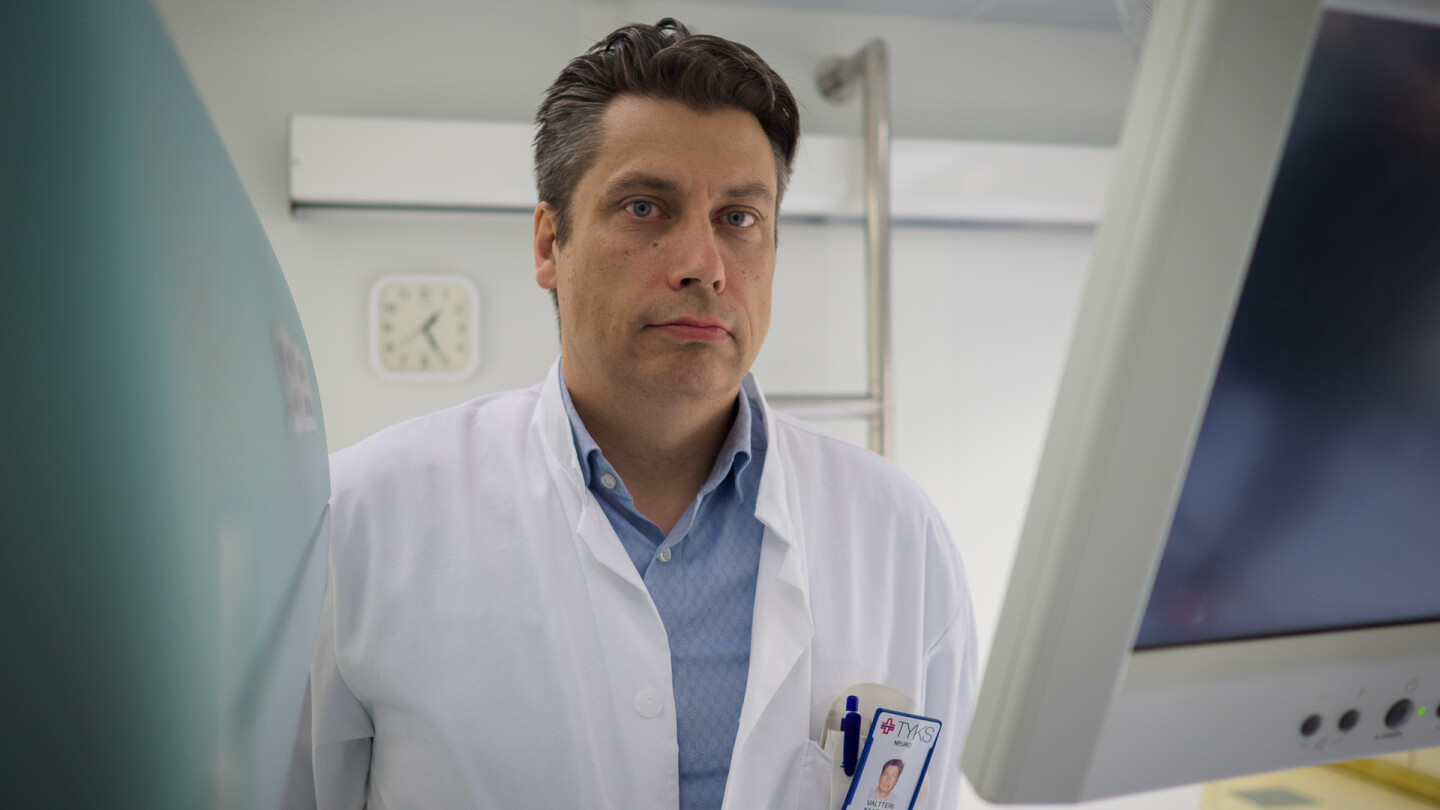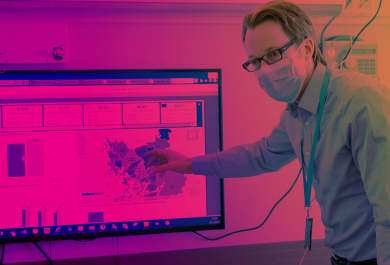Brain researchers from Turku share a strong passion for research and an ability to utilise state-of-the-art technology. PET imaging has provided a window into brain mechanisms, e.g. the principles of addiction or the progress of multiple sclerosis. Brain research is connected to the research and practice of patient care at the University of Turku and Turku University Hospital. This enables the researchers to have a firm grasp on what kind of research can help the patients and allows the quick utilisation of newly acquired expertise.
– A couple of years ago I spent a year at Yale University and witnessed how brilliant researchers develop new technologies which are immediately adopted locally by other researchers, followed by publication of results in top journals. Now we have similar development of top-notch technologies here in Turku together with Turku PET Centre, and we are the ones who get to apply new PET imaging methods in practise to help the patients, says Professor of Neuroimmunology Laura Airas.
Associate Professor and neurologist specialising in movement disorders Valtteri Kaasinen explains how the SPECT gamma camera allows the researchers to see how the brain functions like it was a scene in a movie. Functional brain imaging enables the researchers to e.g. see the changes in neurotransmitters in relation to addiction.
The focus of Assistant Professor of Neuroimaging Juho Joutsa’s research in the Turku Brain and Mind Center is different types of neuroimaging and brain stimulation techniques. Joutsa also works as a consultant neurologist in the Turku University Hospital. His research centres around investigating the mechanisms causing the symptoms of brain disorders and based on that, facilitating the development of new treatment options.
The disorders of brain and mind are perceived as a unified whole:
– Brain stimulation sounds quite scifi-like, but it has already been utilised successfully in the treatment of patients suffering from Parkinson’s disease, dystonia, or depression. These methods may bring new treatment options for several different brain disorders, Joutsa explains.
New Hope in the Treatment of Progressive MS?
Laura Airas is passionate about developing a treatment that would help patients suffering from multiple sclerosis, there being nearly three million of them in the world. Her hybrid job encompasses clinical work in the Turku University Hospital, research work as an Academy of Finland researcher, and working as a professor of Neuroimmunology at the University of Turku.
– The combination of these three is a dream come true. I conduct research, and with the help of my networks, I know about the current developments in treatment. I can adopt the latest discoveries and best expertise from the research around the world to help our patients. It gives me courage to try new treatment options earlier.
Airas finds it important to ensure that new doctors specialising in neurology have a high level of expertise.
– For example, we have a lecture series in neuroimmunology which is offered for doctors specialising in neurology all around Finland.
One of Airas’ research focus areas is multiple sclerosis, in which the progressive stage of the disorder poses a challenge. At that point, the disorder mechanisms causing damage in nerve cells are rampaging in the central nervous system, and there are no more well-functioning medicine options available. Airas’ research interests lie on the study of the immune defence cells of the brain, migroglia cells, where PET imaging has moved the neuroimmunology research to a whole new stage.
– We can study which parts of the brain are currently inflamed at different stages of MS. This provides a whole new window to brain pathology. It is a huge step forward in the research of brain disorders.
Major medicine companies have started to develop medicine for slowing down the progress of multiple sclerosis.
– We have an excellent opportunity to offer out expertise: we can measure what kind of impact the new medicine is having on the brain which allows us to help drug development in a whole new way.
In the long run, the researchers are also planning and hoping to discover biomarkers, proteins and molecules that can be measured in blood circulation and that correlate with the PET discoveries. By being able to achieve this, a blood sample alone could be used to a certain extent to determine the progress of the disorder. Airas believes that this method will be available soon.
Research of the Brain and the Mind
The primary research interest of Valtteri Kaasinen is movement disorders, the most common of which is Parkinson’s disease. However, his research specialities also include addictions. These two interests seem very separate at first glance, but there is a connection between them.
Researchers studying the treatment of Parkinson’s disease were greatly surprised at the time when they discovered it caused gambling addiction in some of the patients. Nowadays, it is known that both addictions and Parkinson’s disease are connected to the neurotransmitter dopamine. That is why Kaasinen’s research interests are clearly connected. Both include the study of basal ganglia and dopamine metabolism.
– One of my main research objectives is improving the diagnostics of Parkinson’s disease. In the early stages, 10–25 percent of the diagnoses are erroneous, which causes undue concern and wrong treatments.
In addition to accuracy, the earliness of the diagnosis should also be improved. Currently, the disorder is diagnosed when the patient suffers from motor symptoms such as rigidity and tremor of muscles. At that stage, already 50 percent of the dopamine nerve cells have been lost.
– Even if we had treatment that protects the nervous system – neuroprotective medicine, which is under development –, we would still need to be able to detect the patients with early-stage symptoms early on.
– Turku is one of the central hubs in this research in Finland, and we are well-known on an international scale.
Research on the Boundaries of Neurology and Psychiatry
Juho Joutsa’s research interests touch on neurology and psychiatry. One of his research interests is addiction disorders. Although dopamine is one of the central aspects in the development of addictions, every medicine targeting the dopamine system has largely failed in the treatment of addictions.
– Our latest discoveries show that, in terms of treatment, the essential aspects lie outside the dopamine system.
These new imaging methodologies allow the researchers to obtain unique information about which part of the brain is “the guilty one”. Using brain stimulation, the treatment can be targeted on these networks.
– If this approach proves effective, we have a powerful tool that can be broadly utilised in the treatment across different brain disorders.
– Clinical work and research fit together very seamlessly. This is an optimal situation from a researcher’s point of view. In clinical patient care, I get to see what is important but what we do not know yet – working at the University offers me an opportunity to try to solve these issues.
Research on the Boundaries of Neurology and Psychiatry
Juho Joutsa’s research interests touch on neurology and psychiatry. One of his research interests is addiction disorders. Although dopamine is one of the central aspects in the development of addictions, every medicine targeting the dopamine system has largely failed in the treatment of addictions.
– Our latest discoveries show that, in terms of treatment, the essential aspects lie outside the dopamine system.
These new imaging methodologies allow the researchers to obtain unique information about which part of the brain is “the guilty one”. Using brain stimulation, the treatment can be targeted on these networks.
– If this approach proves effective, we have a powerful tool that can be broadly utilised in the treatment across different brain disorders.
– Clinical work and research fit together very seamlessly. This is an optimal situation from a researcher’s point of view. In clinical patient care, I get to see what is important but what we do not know yet – working at the University offers me an opportunity to try to solve these issues.
Brain Disorders Also Causing Immense Costs
Turku Brain and Mind Center specialises in research of the fields of neurology and psychiatry. The research centre established by the University of Turku and Åbo Akademi University is also included in the network of Neurocenter Finland.
– Brain disorders touch on almost every Finnish person directly or indirectly. In 2010, their costs were estimated to have reached around nine billion euros in Finland, and that pales in comparison to the suffering they have brought on people, says Risto O. Roine, who has worked as Professor and Chairman of Clinical Neurosciences at the University of Turku and participated in establishing Neurocenter Finland.
However, the latest research has brought effective preventive treatments available even for memory disorders, and treatments affecting the progress of the disorders are currently being developed.
– Turku has been in the frontline of clinical drug research and national drug development. This helps improve brain health and has potential for immense savings. I see that Neurocenter Finland has had a significant role in strengthening the brain research here in Turku.
Roine emphasised that brain health and mental health are tightly linked together.
– The experts of brain health and mental health share the view that there is a demand for a national brain heath programme in Finland.
The strengths of the Turku region in the field of brain health are brain imaging, drug development, and clinical research as well as new innovations. One of the strengths of the area is the active Health Campus Turku, which houses multiple neuroscience companies.
– We are included in broad international networks of the research of, for example, brain injuries, neuroimmunology, and cerebrovascular diseases, Roine summarises.
Turku University Hospital, the Faculty of Medicine at the University of Turku, and the surrounding campus area form a multidisciplinary cluster of excellence in which research and the high-quality treatment based on it form a seamless entity. More than one thousand scientific studies are under way in these organisations, engaging approximately 1,500 experts. Approximately 200,000 patients receive treatment at Tyks every year. Visits to outpatient care total over 1.2 million and days at inpatient care almost 300,000. The University of Turku and the Hospital District of Southwest Finland are part of the Health Campus Turku network, which also includes Åbo Akademi University, Turku University of Applied Sciences, Novia University of Applied Sciences and Turku Science Park Oy.
Text: Sini Silvàn
Photos: Mikael Soininen
Translation: Lotta Junnila
Hero image: The transparent brain and the radioactive matter inserted in its “basal ganglia” help calibrate the gamma cameras. This allows the researchers to receive comparable research results from different studies of the brain, explain Medical Physicist Tommi Noponen and Valtteri Kaasinen.








